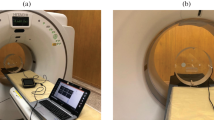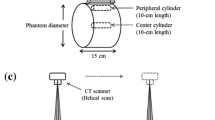Abstract
Estimating the dose delivered to the patient in X-ray computed tomography (CT) examinations is not a trivial task. Monte Carlo (MC) methods appear to be the method of choice to assess the 3D dose distribution. The purpose of this work was to extend an existing MC-based tool to account for arbitrary scanners and scan protocols such as multi-slice CT (MSCT) scanners and to validate the tool in homogeneous and heterogeneous phantoms. The tool was validated by measurements on MSCT scanners for different scan protocols under known conditions. Quantitative CT Dose Index (CTDI) measurements were performed in cylindrical CTDI phantoms and in anthropomorphic thorax phantoms of various sizes; dose profiles were measured with thermoluminescent dosimeters (TLD) in the CTDI phantoms and compared with the computed dose profiles. The in-plane dose distributions were simulated and compared with TLD measurements in an Alderson-Rando phantom. The calculated dose values were generally within 10% of measurements for all phantoms and all investigated conditions. Three-dimensional dose distributions can be accurately calculated with the MC tool for arbitrary scanners and protocols including tube current modulation schemes. The use of the tool has meanwhile also been extended to further scanners and to flat-detector CT.








Similar content being viewed by others
References
Mettler FA, Wiest PW, Locken JA, Kelsey CA (2000) CT scanning: patterns of use and dose. J Radiol Prot 20:353–359
Shrimpton PC, Edyvean S (1998) CT scanner dosimetry. Br J Radiol 71:1–3
BfS (2003) Jahresbericht 2003. Annual rep., Bundesamt für Strahlenschutz, Salzgitter
Brix G, Nagel HD, Stamm G, Veit R, Lechel U, Griebel J, Galanski M (2003) Radiation exposure in multi-slice versus single-slice spiral CT: results of a nationwide survey. Eur Radiol 13:1979–1991. DOI 10.1007/s00330-003-1883-y
Andreo P (1991) Monte Carlo techniques in medical radiation physics. Phys Med Biol 36:861–920
Geant4 Collaboration (2007) Introduction to Geant4. http://geant4.web.cern.ch/geant4/
Team XMC (2003) MCNP-a general Monte Carlo N-particle transport code, version 5. LA-UR-03-1987 RSICC, Los Alamos, USA
Nelson WR, Hirayama H, Rogers DOW (1985) The EGS4 code system. Stanford Linear Accelerator Center, Stanford University, USA
Zankl M, Panzer W, Drexler G (1991) The calculation of the dose from external photon exposures using reference human phantoms and Monte Carlo methods. Part VI: organ doses from computed tomography examinations. Report 31, GSF, Neuherberg
Schmidt B, Kalender WA (2002) A fast voxel-based Monte Carlo method for scanner- and patient-specific dose calculations in computed tomography. Physica Medica XVIII:43–53
Jarry G, DeMarco JJ, Beifuss U, Cagnon CH, McNitt-Gray MF (2003) A Monte Carlo-based method to estimate radiation dose from spiral CT: from phantom testing to patient-specific models. Phys Med Biol 48:2645–2663
DeMarco JJ, Cagnon CH, Cody DD, Stevens DM, McCollough CH, O’Daniel J, McNitt-Gray MF (2005) A Monte Carlo based method to estimate radiation dose from multidetector CT (MDCT): cylindrical and anthropomorphic phantoms. Phys Med Biol 50:3989–4004. DOI 10.1088/0031-9155/50/17/005
Theocharopoulos N, Damilakis J, Perisinakis K, Tzedakis A, Karantanas A, Gourtsoyiannis N (2006) Estimation of effective doses to adult and pediatric patients from multislice computed tomography: a method based on energy imparted. Med Phys 33:3846-3856. DOI 10.1118/1.2349694
Schneider U, Pedroni E, Lomax A (1996) The calibration of CT Hounsfield units for radiotherapy treatment planning. Phys Med Biol 41:111–124
Tucker DM, Barnes GT, Chakraborty DP (1991) Semiempirical model for generating tungsten target X-ray spectra. Med Phys 18:211–218
Boone JM, Seibert A (1997) An accurate method for computer-generating tungsten anode X-ray spectra from 30 to 140 kV. Med Phys 24:1661–1670
Aichinger H, Dierker J, Joite-Barfuß S, Säbel M (2003) Radiation exposure and image quality in X-ray diagnostic radiology. Physical principles and clinical applications. Springer, Berlin
Cullen DE, Hubbell JH, Kissel L (1997) EPDL 97: The Evaluated Photon Data Library, 97 Version. UCRL-50400 6. Lawrence Livermore National Laboratory, Livermore
Chao TC, Bozkurt A, Xu GX (2001) Conversion coefficients based on the VIP-Man anatomical model and EGS4-VLSI code for external monoenergetic photons from 10 kV to 10 MV. Health Phys 81:163–183
Born M (1969) Atomic physics. Blackie and Son Ltd, London
Schardt P, Deuringer J, Freudenberger J, Hell E, Knüpfer W, Mattern D, Schild M (2004) New X-ray tube performance in computed tomography by introducing the rotating envelope tube technology. Med Phys 31:2699–2706. DOI 10.1118/1.1783552
Kalender WA (2005) Computed tomography, 2nd edn. Publicis Corporate Publishing, Erlangen
Kalender WA, Wolf H, Suess C, Gies M, Greess H, Bautz WA (1999) Dose reduction in CT by on-line tube current control: principles and validation on phantoms and cadavers. Eur Radiol 9:323–328. DOI 10.1007/s003300050674
Flohr T, McCollough CH, Bruder H, Petersilka M, Gruber K, Suess C, Grasruck M, Stierstorfer K, Krauss B, Raupach R, Primak A, Küttner A, Achenbach S, Becker C, Kopp A, Ohnesorge B (2006) First performance evaluation of a dual-source CT (DSCT) system. Eur Radiol 16:256–268. DOI 10.1007/s00330-005-2919-2
Riedel T (2005) Deterministic simulation of arbitrary CT measurements with experimental verification. In: Kalender WA (ed) Berichte aus dem Institut für Medizinische Physik, vol 14. Shaker Verlag, Aachen
Ulzheimer S, Kalender WA (2003) Assessment of calcium scoring performance in cardiac computed tomography. Eur Radiol 13:484–497. DOI 10.1007/s00330-002-1746-y
Archer BR, Glaze S, North LB, Bushong SC (1977) Dosimeter placement in the Rando phantom. Med Phys 4:315–318
European Commision (2000) Recommendations for patient dosimetry in diagnostic radiology using TLD. Report EUR 19604 EN, Luxembourg
Tzedakis A, Damilakis J, Perisinakis K, Stratakis J, Gourtsoyiannis N (2006) The effect of z overscanning on patient effective dose from multidetector helical computed tomography. Med Phys 32:1621–1629
Petoussi-Henss N, Zankl M, Fill U, Regulla D (2002) The GSF family of voxel phantoms. Phys Med Biol 47:89–106
Zankl M, Fill U, Petoussi-Henss N, Regulla D (2002) Organ dose conversion coefficients for external photon irradiation of male and female voxel models. Phys Med Biol 47:2367–2385
Kalender WA, Kyriakou Y (2007) Flat-detector computed tomography (FD-CT). Eur Radiol 17:2767–2779. DOI 10.1007/s00330-007-0651-9
Kachelrieß M, Knaup M, Bockenbach O (2007) Hyperfast parallel-beam and cone-beam backprojection using the cell general purpose hardware. Med Phys 34:1474–1486. DOI 10.1118/1.2710328
Acknowledgements
We gratefully acknowledge the help of Oliver Langner and Rosi Banckwitz in relation to dose measurements and TLD reading procedures. This work was financially supported partially by grant AZ 460/01 MEDBILD, Bavarian Research Foundation, Munich, Germany, and partially by the EC-EURATOM 6 Framework Programme (2002–2006) as part of the “Safety and Efficacy of Computed Tomography (CT): a Broad Perspective” project (contract FP/002388). We are grateful to the colleagues at Siemens Medical Solutions who provided the tube current curve information to us for the TCM evaluation.
Author information
Authors and Affiliations
Corresponding author
Rights and permissions
About this article
Cite this article
Deak, P., van Straten, M., Shrimpton, P.C. et al. Validation of a Monte Carlo tool for patient-specific dose simulations in multi-slice computed tomography. Eur Radiol 18, 759–772 (2008). https://doi.org/10.1007/s00330-007-0815-7
Received:
Revised:
Accepted:
Published:
Issue Date:
DOI: https://doi.org/10.1007/s00330-007-0815-7




